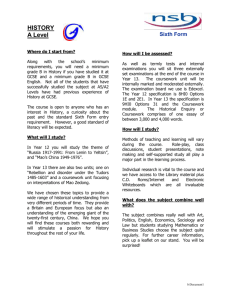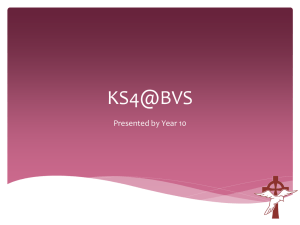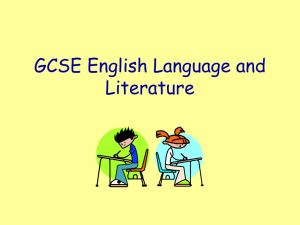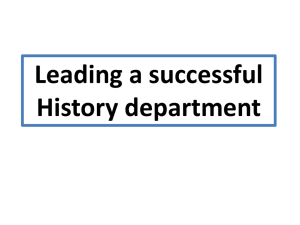Designing – Development and Modelling
advertisement
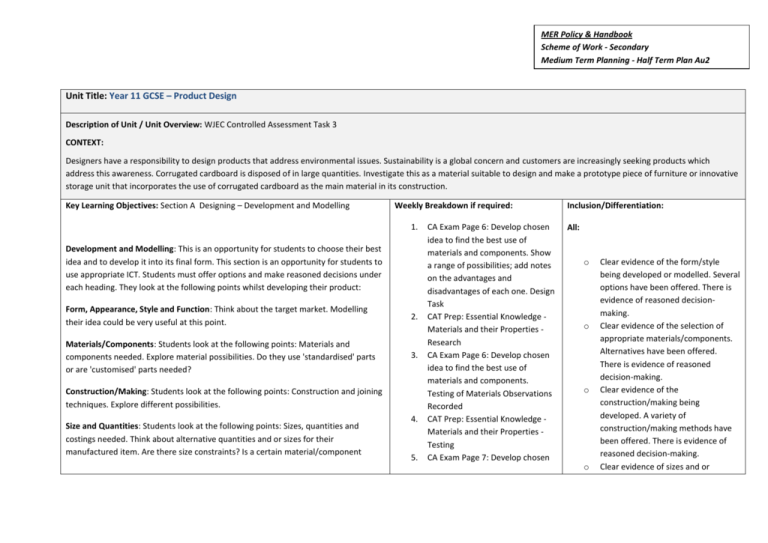
MER Policy & Handbook Scheme of Work - Secondary Medium Term Planning - Half Term Plan Au2 Unit Title: Year 11 GCSE – Product Design Description of Unit / Unit Overview: WJEC Controlled Assessment Task 3 CONTEXT: Designers have a responsibility to design products that address environmental issues. Sustainability is a global concern and customers are increasingly seeking products which address this awareness. Corrugated cardboard is disposed of in large quantities. Investigate this as a material suitable to design and make a prototype piece of furniture or innovative storage unit that incorporates the use of corrugated cardboard as the main material in its construction. Key Learning Objectives: Section A Designing – Development and Modelling Weekly Breakdown if required: 1. Development and Modelling: This is an opportunity for students to choose their best idea and to develop it into its final form. This section is an opportunity for students to use appropriate ICT. Students must offer options and make reasoned decisions under each heading. They look at the following points whilst developing their product: Form, Appearance, Style and Function: Think about the target market. Modelling their idea could be very useful at this point. 2. Materials/Components: Students look at the following points: Materials and components needed. Explore material possibilities. Do they use 'standardised' parts or are 'customised' parts needed? 3. Construction/Making: Students look at the following points: Construction and joining techniques. Explore different possibilities. Size and Quantities: Students look at the following points: Sizes, quantities and costings needed. Think about alternative quantities and or sizes for their manufactured item. Are there size constraints? Is a certain material/component 4. 5. CA Exam Page 6: Develop chosen idea to find the best use of materials and components. Show a range of possibilities; add notes on the advantages and disadvantages of each one. Design Task CAT Prep: Essential Knowledge Materials and their Properties Research CA Exam Page 6: Develop chosen idea to find the best use of materials and components. Testing of Materials Observations Recorded CAT Prep: Essential Knowledge Materials and their Properties Testing CA Exam Page 7: Develop chosen Inclusion/Differentiation: All: o o o o Clear evidence of the form/style being developed or modelled. Several options have been offered. There is evidence of reasoned decisionmaking. Clear evidence of the selection of appropriate materials/components. Alternatives have been offered. There is evidence of reasoned decision-making. Clear evidence of the construction/making being developed. A variety of construction/making methods have been offered. There is evidence of reasoned decision-making. Clear evidence of sizes and or available in the size needed? Use of ICT – Costing Spreadsheet. Theory: Commercial Manufacturing Practices - Question 5 and Knowledge of Materials and Components - Question 6 Stretch/Challenge: o o o o o o o o o o Attend D&T Product Design E&E Clubs on Wednesdays or Thursdays. Extended writing used to write design brief and analysis, write case studies and reports. Coach and Lead others by giving class demos. Use of ICT, 2D Design, Google Sketch Up, Photoshop or Illustrator Software to create illustrations and technical drawings Produce a 3D model of an initial design to test it. Class and Homework is well written and presented in a creative format. Present work to the whole class. Visit Ikea Furniture Store; take related photos of current furniture trends, interview Ikea staff and consumers. Create personal Types of Cardboard resource using recycled cardboard. Label the card and annotate their different properties. Bring in recycled cardboard that could be used to make models during lessons. 6. 7. 8. 9. idea to find the best use of construction. Design Task CAT Prep: Essential Knowledge Construction Techniques Research CA Exam Page 7: Develop chosen idea. Show a range of possibilities; add notes on the advantages and disadvantages of each one. Testing of Construction Techniques Task CAT Prep: Essential Knowledge Construction CA Exam Page 8: Develop chosen idea to work out the sizes, quantities and costings of materials that will be needed to make the solution. Costing Table 10. quantities being developed. Alternative sizes and or quantities will be evident. There is evidence of reasoned decision-making. Most: o Good evidence of the form/style being developed and modelled. Several appropriate options have been offered. There is clear evidence of informed decision making. o Clear evidence of the selection of appropriate materials/components. Appropriate alternatives have been offered. There is clear evidence of reasoned decision-making. o Clear evidence of the construction/making being developed. A variety of appropriate construction/making methods have been considered. There is evidence of well-reasoned decision-making. o Clear evidence of sizes and or quantities being developed. Sizes and or quantities have been developed in a progressive way. There is evidence of reasoned decision-making. CAT Prep: Essential Knowledge Costing, Size, Quantities of Material and Mock Exam 2: Written Exam 11. CA Exam Page 8: Develop chosen idea to work out the sizes, quantities and costings of materials that will be needed to make the solution. Developed Design Ideas relating to Costing, size, quantities of materials. 12. Submit pages 1 to 8 for marking. Some: English Exam - Tuesday 15th Dec p.3 o A variety of forms/styles have been presented and the shape and form of the product have been developed and modelled in a progressive way. A final decision based on sound reasoning has been made. o Full and clear evidence of the selection of appropriate materials/ components. Appropriate alternatives have been offered. There is evidence of well-reasoned decision-making. o Full and clear evidence of the construction/making being developed. A range of appropriate construction/making methods has been considered. There is evidence of well-reasoned decision-making. o Full and clear evidence of sizes and or quantities being developed. Alternative sizes and or quantities have been systematically evaluated. There is clear evidence of wellreasoned decision-making. Homework opportunities: 1. 2. 3. 4. 5. Attend GCSE Product Design Homework Club on Wednesday or Thursday (lunch or after school). Coursework: Develop your chosen idea to find the best use of materials and components. Make one or two mini models and test construction and joining techniques. Exam Revision: - Materials and their Properties – Research types of card/board/paper/plastics. What are their properties? Are the suitable for sustainable furniture? Extension: Create a Materials Board using recycled cardboard/paper. Present to the whole class. Attend GCSE Product Design Homework Club on Wednesday or Thursday (lunch or after school). Coursework: Testing of Materials and Observations Recorded. Exam Revision: - Research types of Materials Testing Techniques carried out in Industry. Extension: Visit Ikea Store in Croydon and see how their chairs are tested. Write a report on your findings. Attend GCSE Product Design Homework Club on Wednesday or Thursday (lunch or after school). Coursework: Testing of Materials and Observations Recorded. Exam Revision: What is the British Standards Institution (BSI)? How it is related to the Committee for European Standardisation (CEN) and the International Standards Organisation (ISO)? Attend GCSE Product Design Homework Club on Wednesday or Thursday (lunch or after school). Coursework: Testing of Materials and Observations Recorded. Exam Revision: What are packaging (Essential) Regulations (P(ER)R) 2003? Explain how it is implemented in the provisions of the European Directive on Packaging and Packaging Waste affect Packaging design. Attend GCSE Product Design Homework Club on Wednesday or Thursday (lunch or after school). Coursework: Testing of Materials and Observations Recorded. Exam Revision: Carry out a "Life Cycle Analysis" to determine the environmental impact of a product. Record your notes on a Revision Map. Extension: Write magazine article on The Life Cycle of a Related piece of Furniture. Assessment Focus: o GCSE Product Design Assessment Criteria: Development and Modelling – FASF, Materials, Construction and Size o Essential Knowledge: Past Paper Mini Mock Exam 2 o Literacy: Quality of Written 6. 7. Attend GCSE Product Design Homework Club on Wednesday or Thursday (lunch or after school). Coursework: Costing Table for your Product. Exam Revision: Research Designer James Dyson. Record your notes on a Revision Map. Extension: Write a report The Life and Work of James Dyson. Important: Complete Pages 6 to 8 for Marking and submit by Tuesday 15th Dec Holiday Homework: Due Tuesday 5th Jan. Design Review and Development Planning (see worksheet provided). Exam Revision: Research Types of Commercial Manufacturing - Revise the key points below: Primary Processing. Secondary Processing. Quality Control. Quality Assurance. Tolerance. Record your notes on a Revision Map. Extension: Write a class worksheet that explains how these processes apply to your own product and present your work to the class. Cross Curricular Opportunities: Literacy: Students are encouraged to:o o o o o o o o Use correct Spelling, Punctuation and Grammar. Use Adjectives, Connectives and Complex Sentences. Not to copy and paste text from the internet. Read, understand and record interesting facts in their own words. Remember to use KEY technical words in Product Design. Present their work to small groups or whole class to develop oracy skills. Present their work in an orderly and chronological order. Design folder is focused, concise and relevant and demonstrates an appropriate selection of material for inclusion o o All decisions communicated in a clear and coherent manner with appropriate use of technical language The text is legible, easily understood and shows a good grasp of grammar, punctuation and spelling Enterprise: Numeracy: Students are encouraged to use the following HAPU Enterprise Skills:- Students are encouraged to:- o o o o o o Creating – 2D and 3D models Presenting – Home and Class work to the whole class Communicating – Annotation of Design Development pages Evaluating – Design Ideas Reflecting – Tasks Analysis Personal Best – Making improvements through each development stage o o o o o Scale and placement of designs/patterns Costing and Size Scaled Measurements 2D and 3D Modelling Scale and volume of manufacture Digital Learning: SMSC: Students are given opportunities to use ICT to:- Students are given opportunities to:- o o o o o o Designer Research Industry Practice Research Use the internet to research materials and their working properties Use of CAD Software - 2D Design, Google Sketch Up, Photoshop or Illustrator to create illustrations and technical drawings Use MS Excel to create costing spreadsheets Use to create comparative analysis tables during Construction and Materials Testing activities. o o o o Social: Peer Feedback during designing tasks. Moral: Designer Responsibilities, the 6Rs and Sustainability in Design Spiritual: Safe use of Product Design equipment. Pride and ownership of outcomes. Culture & British Values: British Industry practice. British Designer Research. Links to own culture evident in design ideas. BSI.
